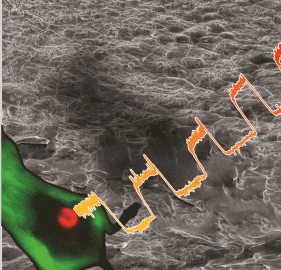 Humans have evolved to be completely dependent on oxygen and cannot survive without it for more than a few minutes. While a number methods have been developed to detect the levels of this critical molecule in blood, long-term monitoring of subcutaneous oxygenation has proved challenging. Numerous phosphorescent dyes have been demonstrated to be excellent oxygen biosensors but have not been able to be permanently incorporated into biocompatible implantable polymers at high enough concentrations to enable long-term transdermal detection.
Humans have evolved to be completely dependent on oxygen and cannot survive without it for more than a few minutes. While a number methods have been developed to detect the levels of this critical molecule in blood, long-term monitoring of subcutaneous oxygenation has proved challenging. Numerous phosphorescent dyes have been demonstrated to be excellent oxygen biosensors but have not been able to be permanently incorporated into biocompatible implantable polymers at high enough concentrations to enable long-term transdermal detection.
Now, a team lead by Prof. Jonathon Lovell at the University of Buffalo have deveoped a novel strategy that uses palladium porphyrins as active crosslinkers with PEG comonomers to create a biocompatible implantable hydrogel for non-invasive oxygen sensing. A tetracarboxy porphyrin was reacted with PEG diamines under conditions that resulted in nearly quantitative dye incorporation. The polyamide was formed with millimolar porphyrins which exhibited near infrared phosphorescence, which is ideal for in vivo detection.
Additionally, the spatially constraining mesh of the PEG-porphyrin matrix prevented porphyrin aggregation that would normally occur at such dye concentrations and attenuate the phosphorescence. The hydrogel could be implanted in mice for weeks without any sign of toxicity, signal loss or polymer degradation and could non-invasively detect changes in subcutaneous oxygen levels via transdermal phosphorescence detection.

















